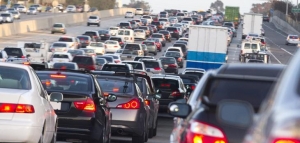
For $63.4 billion, you could have bought all 10 of the nuclear powered aircraft carriers in the U.S. Navy’s inventory, or five copies of the new generation of carriers scheduled to enter service in 2020. And, oh, by the way, you’d have several billion left to buy the 90 planes and 30 helicopters that the new ships can carry.
For $63.4 billion, you also could buy all 195 F-22 Raptor fighter jets ever built, and have several billion left to train the pilots who fly the world’s most sophisticated warplane.
For $63.4 billion you could have bought Anheuser-Busch — which Europe’s InBev did in 2008 for $58 billion in 2016 dollars — and still have more than $5 billion left over to provide really nice care for all those Clydesdales.
Or, you could have wasted every penny of it idling in traffic, which is what a new report from the American Transportation Research Institute says the U.S. trucking industry did in 2015.
That’s one enormously expensive traffic jam. And though it’ll be another year before the cost of traffic congestion in 2016 is reported, it’s a safe bet that that number will be even higher.
It’s physically impossible to avoid every traffic jam, accident-caused backup, or known highway bottleneck, but a number like $63.4 billion should have the industry moving to find ways to dramatically reduce its exposure to such an enormous loss of efficiency and money. To be sure, while some of those congestion-driven costs — higher fuel and maintenance costs, reduced asset and equipment utilization, late delivery penalties paid, higher driver costs, lost retail sales because of unavailable inventory tied up in trucks stuck in traffic, and more — are passed on to customers in the form of higher transportation bills, trucking companies swallow a big chunk of those costs. But however it’s accounted for, most of that $63.4 billion a year comes right off the bottom line of supply chain companies.
Using technology to avoid profit-sucking bottlenecks
But how can trucking companies ranging from huge fleet operators to one-truck owner/operator outfits significantly lower their exposure to highway congestion? After all, the very nature of trucking requires most trucks to operate most of the time in and around densely populated urban areas, on the crowded interstates and other major highways between population centers. Those all are inherently prone to congestion.
The most obvious step is to promote better, safer driving habits, not only among truck drivers but also among the general public. According to the ATRI report, the number of police-reported traffic accidents in 2015 rose nearly 4 percent over 2014. That jump was one of the biggest contributors to a surprisingly large increase in highway congestion. But the reality is that the trucking industry has little control over how well private motorists perform behind the wheel. So most of its efforts toward reducing congestion costs are focused on technology-driven solutions aimed at helping truck drivers avoid congestion whenever possible.
For instance, there are technology solutions designed to better plan routes to avoid common choke points, alert drivers of slowdowns ahead in plenty of time to re-route them, to integrate customer delivery demands into the fleet and daily operations planning process to reduce lost time and waste, and to accurately track trucks and loads so that clients can be kept up-to-date on when to expect their deliveries. But there are dozens of technology providers offering systems that do one, two, or many of those functions for trucking operations that compete in regional and national markets and in all specialty categories.
Some provide route planning and congestion warning services to small operators or even to one-truck companies operating on shoestring budgets. Others provide sophisticated systems that track highway construction data bases, police radio activity and even entire fleets for tell-tale signs of unexpected slowdowns and clogged highways. When many trucks in the same area are moving at unusually slow speeds, when many of the trucks within a mile or two of each other are having to use their brakes heavily, or when many of the trucks bound for destinations in the same city all are significantly behind schedule it’s likely that some unexpected or unplanned bottleneck has cropped up. Such real-time knowledge then can be used to guide still more trucks headed in the same direction around the bottleneck(s) or, at the very least, how to get through the bottlenecks with the least amount of schedule disruption possible.
Such technology systems also produce, almost as a by-product of their tracking and warning functions, massive databases on which well-managed trucking firms can rely to create highly optimized route plans that can remove 5 percent to 15 percent of time from the average truck’s daily schedule, even on days when they encounter no major bottlenecks.
Based on that $63.4 billion in congestion costs in 2015, eliminating just 15 percent of that time lost to congestion would produce $9.5 billion in economic savings. Cutting a more challenging 25 percent of congestion-driven costs would put $15.9 billion back into the pockets of trucking companies.
So the question is not whether trucking companies should be employing technologies to reduce their exposure to traffic congestion. Of course they should. Rather, the real question is why trucking companies aren’t doing even more today to learn, in advance, where congestion likely will be encountered by each of their trucks and how they can best steer their drivers and their rigs around those profit-sapping, driver-maddening, and customer-disappointing bottlenecks?
